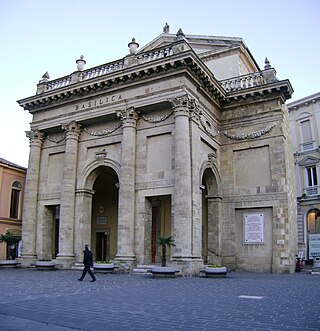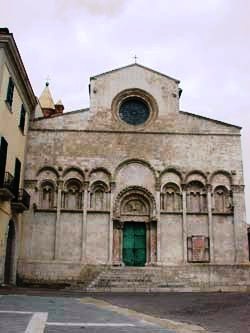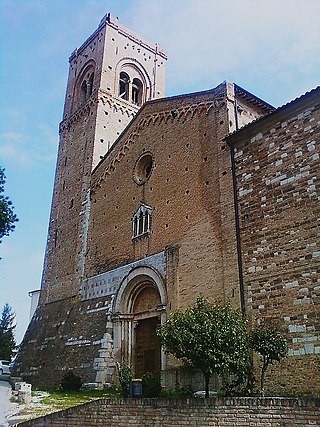
The Archdiocese of Fermo is a Roman Catholic ecclesiastical jurisdiction in northern Italy, with its seat in the city of Fermo, Marche. It was established as the Diocese of Fermo in the 3rd century, and elevated to an archdiocese by Pope Sixtus V on 24 May 1589. The archiepiscopal seat is Fermo Cathedral. The current archbishop is Rocco Pennacchio.

The Diocese of Macerata-Tolentino-Recanati-Cingoli-Treia is a Roman Catholic diocese in Italy. It is a suffragan of the Archdiocese of Fermo.

The Diocese of Recanati was a Roman Catholic diocese in Italy. It was founded in 1240 by Pope Gregory IX.

The Roman Catholic Metropolitan Archdiocese of L'Aquila is an ecclesiastical territory or diocese of the Roman Catholic Church in Italy. It was erected as the Diocese of Aquila on 20 February 1257 by Pope Alexander IV and promoted to an archdiocese by Pope Pius IX on 19 January 1876. Pope Paul VI elevated it to the rank of a metropolitan archdiocese on 15 August 1972, with the suffragan sees of Avezzano and Sulmona–Valva.

The diocese of Montefiascone was a Catholic ecclesiastical territory in Italy. It was created from the diocese of Bagnorea in 1369. In 1986 was united into the diocese of Viterbo, Acquapendente, Bagnoregio, Montefiascone, Tuscania e San Martino al Monte Cimino. The diocese was immediately subject to the Holy See (Papacy).

The diocese of Cortona was a Roman Catholic ecclesiastical territory in central Italy, which existed from 1325 to 1986. It was immediately subject to the Holy See.

The Italian Catholic diocese of Arezzo-Cortona-Sansepolcro has existed since 1986. In that year the historic diocese of Arezzo was combined with the diocese of Cortona and the diocese of Sansepolcro, the enlarged diocese being suffragan of the archdiocese of Florence.

The Diocese of Teramo-Atri is a Roman Catholic ecclesiastical territory in Abruzzo, central Italy. The current extent of the diocese was established in 1949, when the historic Diocese of Teramo was combined with the Diocese of Penne-Atri, in the Abruzzo. It is suffragan of the Archdiocese of Pescara-Penne.

The Archdiocese of Pescara-Penne is a Roman Catholic ecclesiastical territory on the east coast in central Italy.

The Italian Catholic Archdiocese of Chieti-Vasto received that name in 1986, when the two separate dioceses, which had been governed by one and the same bishop, were united in one diocese. The diocese of Chieti had become the Archdiocese of Chieti in 1526, when promoted by Pope Clement VII. Chieti is about 8 miles south-west of the Adriatic port city of Pescara.

The Catholic diocese of Fossombrone existed in the Italian province of Pesaro and Urbino, in the comune of Fossombrone, in the valley of the Metaurus River, 25 km southwest of the Adriatic seaport of Fano. In 1986, the diocese was suppressed and its territory incorporated into the diocese of Fano-Fossombrone-Cagli-Pergola. Up to 1563, the diocese had been directly subject to the papacy. It then became a suffragan of the archdiocese of Urbino. In 2000, Urbino lost its metropolitan status, and Fossombrone became part of the ecclesiastical province of Pesaro.

The Roman Catholic Archdiocese of Lanciano-Ortona has existed under this name since 1986. Since 1982, it has been a suffragan of the Archdiocese of Chieti-Vasto.

The Catholic diocese of Termoli-Larino is situated in the province of Campobasso, region of Molise. The commune of Termoli is an important regional seaport. The diocese has existed in its current configuration since 1986, when the diocese of Larino was suppressed and added to its territory. It is a suffragan of the archdiocese of Campobasso-Boiano.

The Diocese of Avezzano is a Roman Catholic ecclesiastical territory in central Italy, whose name in Italian was changed in 1986. It was previously known as the Diocese of Marsi, as it still is in Latin. It has been a suffragan of the Archdiocese of L'Aquila since 1972.

The Italian Catholic Diocese of San Miniato is in Tuscany. It is a suffragan of the archdiocese of Florence.

The Italian Catholic Diocese of Oria is in Apulia. It is a suffragan of the Archdiocese of Taranto.

The former Italian Catholic Diocese of Chiusi-Pienza, in Tuscany, existed until 1986. In that year it was united into the Diocese of Montepulciano-Chiusi-Pienza. The Diocese of Chiusi (Clusinus) was at first immediately subject to the Holy See, but was made a suffragan of archdiocese of Siena by Pope Pius II. From 1459 to 1986, it was a suffragan of the archdiocese of Siena.

The former Italian Catholic Diocese of San Severino, in the Province of Macerata, Marche in Central Italy, existed until 1986. In that year it was united into the Archdiocese of Camerino to form the Archdiocese of Camerino-San Severino Marche.

The Diocese of Montalcino was a Roman Catholic diocese located in the town of Montalcino to the west of Pienza, close to the Crete Senesi in Val d'Orcia in Tuscany, Italy. In 1986, it was suppressed and united with the Diocese of Colle di Val d'Elsa and the Archdiocese of Siena to form the Archdiocese of Siena-Colle di Val d'Elsa-Montalcino.
Carlo Bonafaccia was a Roman Catholic prelate who served as Bishop of Terni (1675–1683) and Bishop of Ortona a Mare e Campli (1653–1675).



















